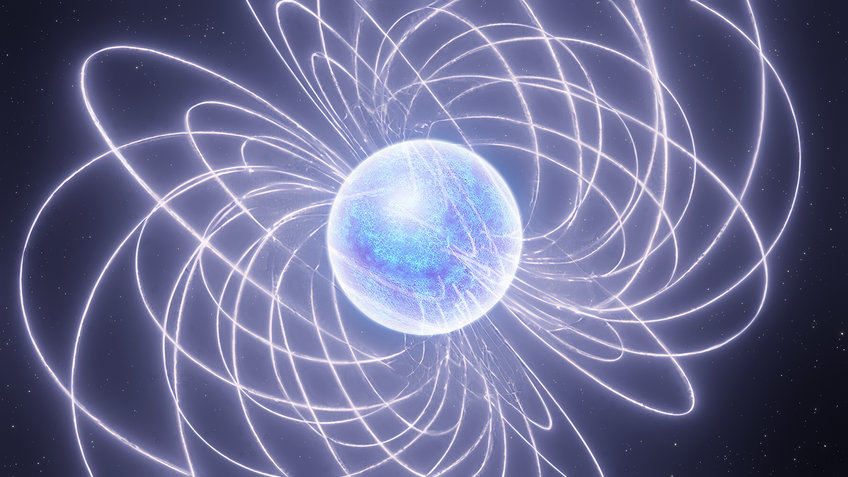Extreme stars share unique properties that may provide a link to mysterious sources
A universal relation for pulsars, magnetars and potentially fast radio bursts
An international research team led by Michael Kramer and Kuo Liu from the Max Planck Institute for Radio Astronomy in Bonn, Germany, have studied a rare species of ultra-dense stars, so called magnetars, to uncover an underlying law that appears to apply universally to a range of objects known as neutron stars. This law gives insight into how these sources produce radio emission and it may provide a link to the mysterious flashes of radio light, Fast Radio Bursts, that originate from the distant cosmos.

Neutron stars are the collapsed cores of massive stars, concentrating up to twice the mass of the sun in a sphere of less than 25 km diameter. As a result, the matter there is the most densely packed one in the observable Universe, squeezing electrons and protons into neutrons, hence the name. More than 3000 neutron stars can be observed as radio pulsars, when they emit a radio beam that is visible as a pulsating signal from Earth, when the rotating pulsar shines its light towards our telescopes.
The bipolar magnetic field of neutron stars ensures that the radio light is concentrated in cones. The magnetic field of normal pulsars is already trillions of times stronger than the Earth's magnetic field, but there is a special type of neutron star whose magnetic field is thousands of times stronger: the so-called magnetars. Of the 30 or so known magnetars, radio pulses have so far only been measured in six of them. Researchers from the Max Planck Institute for Radio Astronomy, supported by colleagues from the University of Manchester, have analysed the individual pulses of these magnetars in detail and discovered a common substructure in them. It turned out that a very similar pulse structure was also observed in rapidly rotating radio pulsars and in other neutron star signals, the so-called "Rotating Radio Transients". "We did not expect that all radio-emitting neutron stars share this universal scaling", says Michael Kramer from the Max Planck Institute for Radio Astronomy.
This indicates that the actual origin of the subpulse structure must be the same for all neutron stars that emit radio radiation. This commonality even allows conclusions to be drawn as to which physical processes in the plasma around the neutron stars ensure that these particular stars generate radio radiation in the first place. The so-called fast radio bursts, a hitherto largely unknown source of fast radio bursts from the deep universe, can also possibly be traced back to neutron stars via the characteristic correlation of radio pulse curves that has now been found. "If at least some FRBs originated from magnetars and if we found this periodicity in the data, this would be a milestone in the explanation of fast radio bursts", says Ben Stappers from the University of Manchester.
Additional Information
Magnetars are among the most energetic neutron stars attributed to their extremely high magnetic fields. Out of the above thirty magnetars discovered so far, only six are known to exhibit radio emission. Recently, research interest in their properties has drastically increased due to their possible link to fast radio bursts (FRBs). FRBs are millisecond-long bursts of radio emission generated by extra-galactic sources. Though the origin of these radio bursts has not been understood, magnetars are speculated to be one of the possible FRB sources.
Sub-structure with short-duration, concentrated emission was detected in the radio signal of pulsars soon after their first discovery. Typically, the sub-structure has a characteristic quasi-periodicity and width, both of which have been found to scale with the rotational period of the pulsar. This relation has been established in canonical pulsars for decades, and expanded to the millisecond pulsar population in recent years. Very recently, the same type of short-duration ‘micro-pulse’ has also been seen in some FRBs, indicating the presence of a similar underlying emission process in both scenarios.
The research used observations of all six radio-loud magnetars which were carried out by the Effelsberg 100-m telescope at CX band (4-8 GHz) and a few other 100-m class radio telescopes around the globe.
